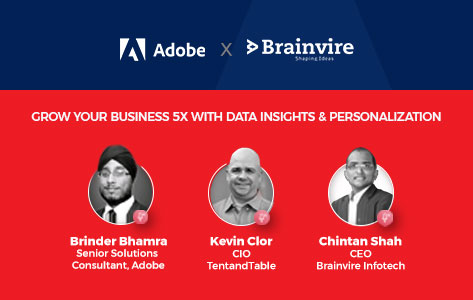Today is the era of connectivity with different channels. The consumer marketplace is no exception. A business is successful when it is apt to anticipate the needs of customers. Meeting the needs of customers is not enough you need to exceed for a successful business.
The marketplace is constantly fluctuating and to become apt and efficient businesses need to harness the latest analytics and power of artificial intelligence. Businesses need to make necessary changes, adapt, and evolve to thrive.
Robust marketing strategies are not enough because consumers’ expectations keep changing. Competitions are becoming fierce. The data is more detailed. The challenges of the modern-day marketplace need to meet with a digital-first mindset, use AI to create authentic and strong interactions with the customers. The effective use of technologies is to capitalize data for insight drive results.
The CMO’s Challenges:
The major challenges of Chief Marketing Officer (CMO) are:
- Consumers changing expectations
- Fierce Competition
- Increasing Data
The answer to critical Business Growth Challenges is E-commerce Personalization- AI-powered robust marketing strategy.

Changing Expectations
Marketing leaders have recognized the importance of superior customer experience as a competitive advantage. The customer experience is critical for retaining current customers and new customers. The digital landscape is crowded and yet to maintain and increase revenue customer experience is becoming more important with the increase in globalization the customers have an abundance of choices.
Every market leader will agree and state that is a fact that customer relationship management is an integral business strategy for customer experience to create loyal and lasting customer relationships. To meet these changing consumers’ expectations brands need to use data and analytics better. Important is to have a better understanding of customers so that a personalized experience can be created for customers. Meet the expectations of customers.
Fierce Competition
Competition has become more advance and fierce. Traditional business models are lost as its outdated. E-commerce businesses are constantly challenged with new entrants in the market which offer a lower price and innovative experience.
E-commerce business has become a crowded sector. There is increased spending in the hope to catch and reach more customers. It is a competitive landscape. AI-powered marketing offer capabilities to make a more meaningful impression on customers with exposure to the brand’s message, forge deeper bonds and excel in the marketplace.
Increasing Data
Years back customer collection was done on disconnected systems through call centers and point of sales. With latest in advanced data technology and digitization allows e-commerce businesses to use proprietary and third-party data that creates detailed pictures of the customers to gain a deep understanding of their preferences and behavior.
The AI power marketing technology must be used to soften through a large amount of information in real-time. This gives insights and offers insight-driven decisions regarding types of interaction to have with the customers.
Businesses must use available data along with AI technology that will accelerate results and offer Ecommerce personalization experiences that will attract and retain your business loyal customers.
For CMO to lead and excel business in the marketplace today, they need to adopt an E-commerce personalization marketing strategy for exploring data, use advanced analytics and AI technology that is embedded through customer journey which generated new levels of industry-specific insights and actions for customers.
The CMO must focus to become more customer-centric, data-driven with AI-powered personalization to provide appropriate solutions.
E-commerce Personalization
E-commerce Personalization is delivering personal experiences on the website through dynamic content like product recommendations, specific offers that are based on previous actions of the customer, browsing behavior and purchase history, demographics, and other relative data.
Personalization is important for every business that is seeking to engage with customers but it’s vital for repeat purchases, upselling and cross-selling, sales, and increase conversion.
Customer’s know-how about the personalization through product recommendations on the homepage, through ads, product details, to card abandonment marketing emails, onboarding quizzes, personalized showroom of products, etc.
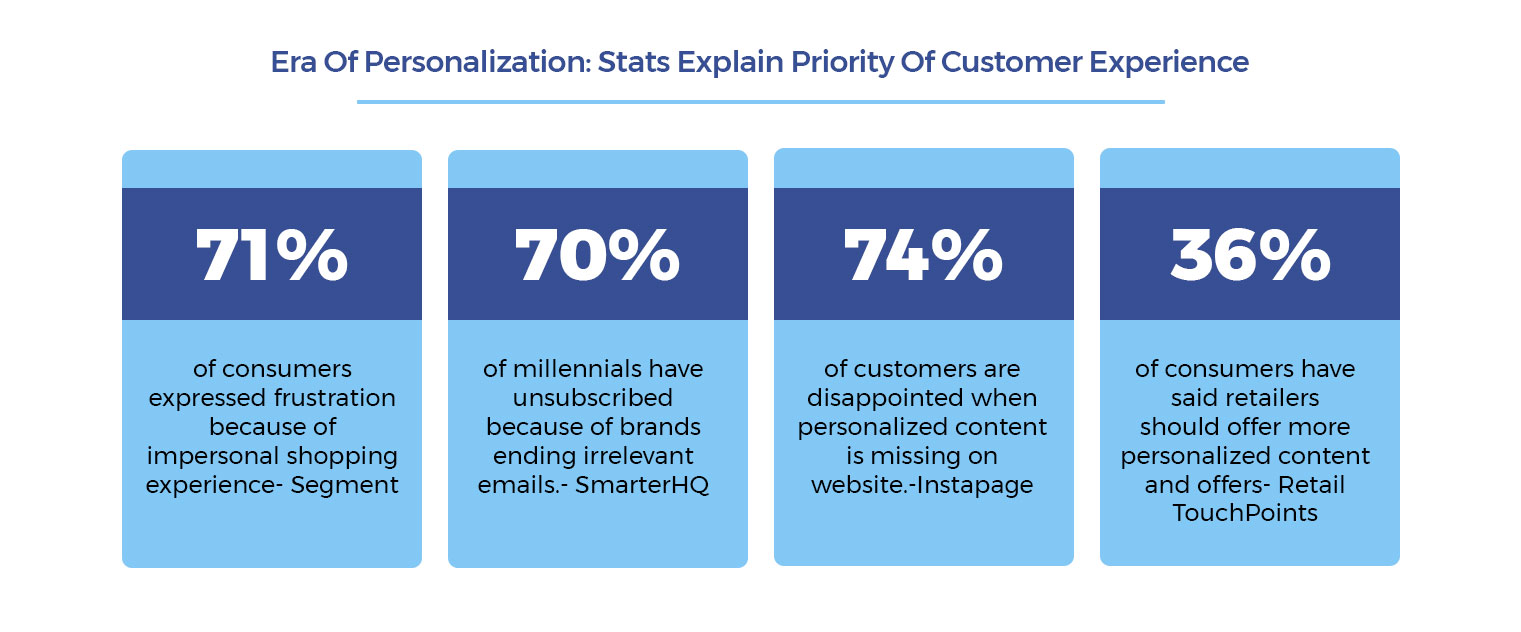
Now let us explain why personalization in E-commerce is essential with the stats from studies conducted.
Before digital commerce customers used to walk in stores and find a friendly clerk to help them to find what they want but this kind of personal customer attention remains rare in the digital realm.
This is the age of customers, the brands, retailers, and B2B companies need to offer personalized customer experience. The benefits of personalization for E-commerce business:
The pandemic triggered a cultural reset of consumer attitude towards shopping as many new habits and behaviors have formed. Customers are seeking out a more personalized experience.
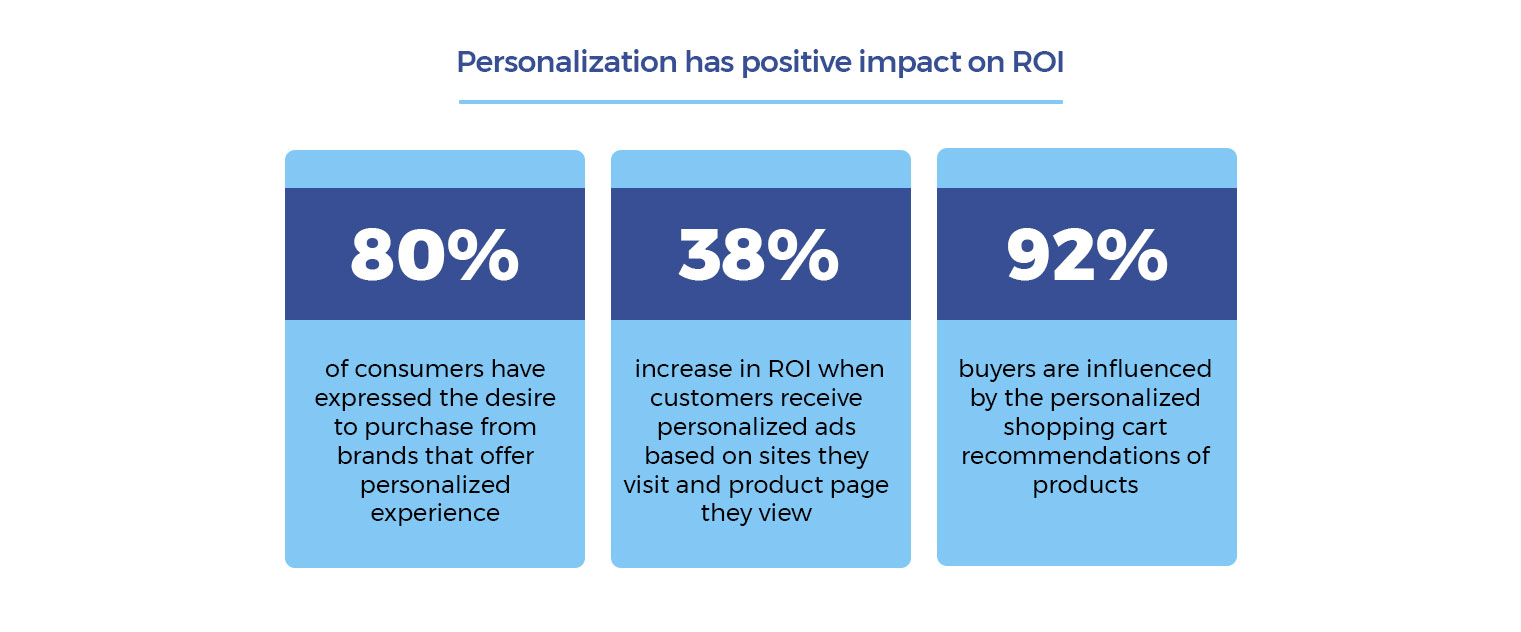
A luxury retail expert Pam Danzinder has stated “Coming out of this crisis, we're going to see even more distinction between the idea of going shopping as an experience and having to buy something - the shopping experience and buying have become disintermediated.”
The Holy Grail of Business longevity is the loyal customer base. Keeping your customers happy and loyal needs a blend of optimization of product offering and customers experiences.
The University of Texas conducted a study that states that personalization comes from citation to control and simplification of decision making.
The personalization service or product/interactions give an experience that makes customers the center of all corporate decisions. One very important thing about personalization is that it gives customers greater control over interactions.
It further influences customers’ decision process as information is presented and tailored to personal needs and is relevant where it is required. Customers have expectations that brands use their data shared to understand and reflect on their needs and provide a better shopping experience.
It is a combination of understanding of the customer, convenience, emotional engagement that drives loyalty. This increases returns for the business.
Ignoring personalization brands risk:
- High customer fallout rate at all stages of the customer funnel
- Low return on ads and relative investment
- Reduce customer loyalty
- Few impulse purchases
- High product returns because customers don't feel the brand or product understands their needs.
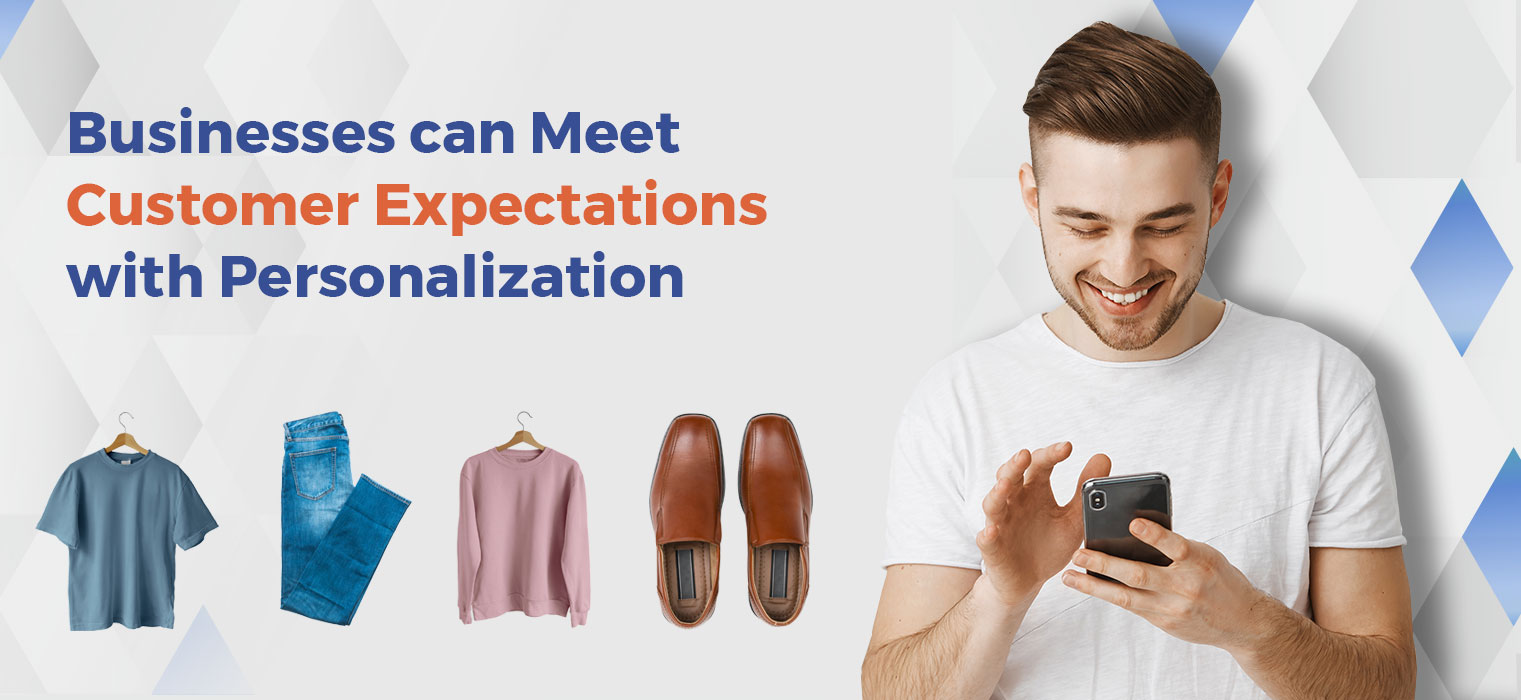
CMO Goals are:-
Profits
Business is done for profit. CMO has to drive business growth with the re-imagined platform, offer service design, execute plans of delivery of top-line revenue and return on investment. The CMO leads to a shift from a cost center to a profit center. They integrate product and services development with sales and marketing.
Innovation and Optimization
Innovate new marketing strategies, integrate them with a tool that drives growth and cost reduction. Ensure lower customer acquisition and retention costs because of personalized product targeting and execute relative campaigns.
Improvement of Experience
Improve customer experience by creating a consistent and personalized brand experience. Ensure your customers have a memorable brand experience consistently throughout various media. Have a deeper understanding of what your customers need and what are the different but relevant touchpoints.
Data-driven Decisions
Through metrics and analytics, you must make data-driven decisions and handle risk management.
E-commerce Personalization Marketing can help CMO with:
Maximization of Revenue
- Data-driven generation of content
- Detailed product and service targeting
- Next best recommendation
- Dynamic pricing
Reducing Cost
- Reduction of customer acquisition
- Reduction of retention costs
- Workflow automation to reduce cost
Improvement of customer experience
- In-moment of customer journeys
- 24/7 customer service
- Real-time segmentation
- Dynamic landing pages
- Responsive websites
Personalization begins with Data collection:
Before getting to the practical application of E-commerce personalization it is important to understand and establish the foundation of personalization: Data Collection
Data Collection is the cornerstone of the customer personalization of the customer journey from start to end, discovery to purchase, and repeat purchase.
Customer touchpoints critical for data collection for E-commerce personalization:
- On-site interaction in category page and product page
- Traffic
- Personal Data
- Paid media Pixels
- Purchases
- Pricing
- Search
It is important to understand:
- What points that you need to track
- Whom you are tracking
- When to track data – in Real-time
- Tools and platforms to use to track
Where should E-commerce personalization occur in the experience?
All touchpoints and the channels your customers are interacting with your business. Product recommendations, location-based services, inspirational content, site search, and customer portals that map out all micro-moment benefiting from the contextual experience.
What information would be used for the creation of personal experience?
A wealth of information from CRM, A/B testing, marketing automation, transactional system are tools for you to map where personalization can occur and decide on what current tools can help support each micro-moment, and identification of gaps in data that needs to be filled to complete.
What technology and insights to use for personalization?
Read further as you will find answers to all these gradually.
The key difference between B2B and B2C personalization
Studies have found 75% of B2B buyers want customization and personalization experiences that are like B2C. The study has found 22% of B2B customers have experienced online personalization.
Multi-Layered Persona: Personalization to an individual is not that easy, with B2B it gets more complex when you consider account, department, vertical, and application.
Diverse Customer Base: when it comes to B2B the customer base is diverse like there are researchers, technicians, customer service reps, etc. providing the right information without the hassle s of skimping through thousands of SKUs.
Complex Product Catalog: B2B requires a funnel-based catalog, a personalized catalog with different education levels. So B2B companies need contextual targeting that is based on the understanding of industry, accounts, depending on cases and products.
Use AI with intelligent personalization solutions for B2B customers.
Role of AI and Advance Technology in E-commerce Personalization:
The major driver of E-commerce personalization is Artificial Intelligence(AI). Machine learning or AI crunches data and enables real-time optimizations and scalability. Businesses utilize collected and processed data for the recommendation of personalized products to the customers in real-time and thus design a user-oriented customer experience.
Algorithms determine the information that helps content creators to prioritize rising topics, trends, and needs that actual customers are interested in. These are identified with AI quickly without a lot of manpower.
As more and more devices are connected and robust data models businesses find unique means of data collection and connecting with customers.
Online tracking through cookies allows brands to have a better understanding of customer preferences. Various tools like customer data platforms, third-party data, loyalty programs, censuses, and ethically shared data enable a detailed description of customers and understanding much better than traditional customer segments.
Data collection is augmented with advancements in analytics and AI. AI helps businesses to sift through a large amount of information in real-time and make real-time decisions and types of interactions with customers.
The combination of data and advanced tech is disrupting traditional means of interaction with customers. It enables businesses to reach customers with targeted media, and content relevant and customized.
E-commerce Personalization technologies and strategies:
There is no single strategy or tactic or class of technology for digital business to define personalization. It is in no way simple as there is a whole spectrum of technologies that are involved to create personalization. You will have to create your roadmap.
To get customers to the goal of the moment as a marketer you need to understand customers, and tailor according to the experience across all levels the technologies offer.
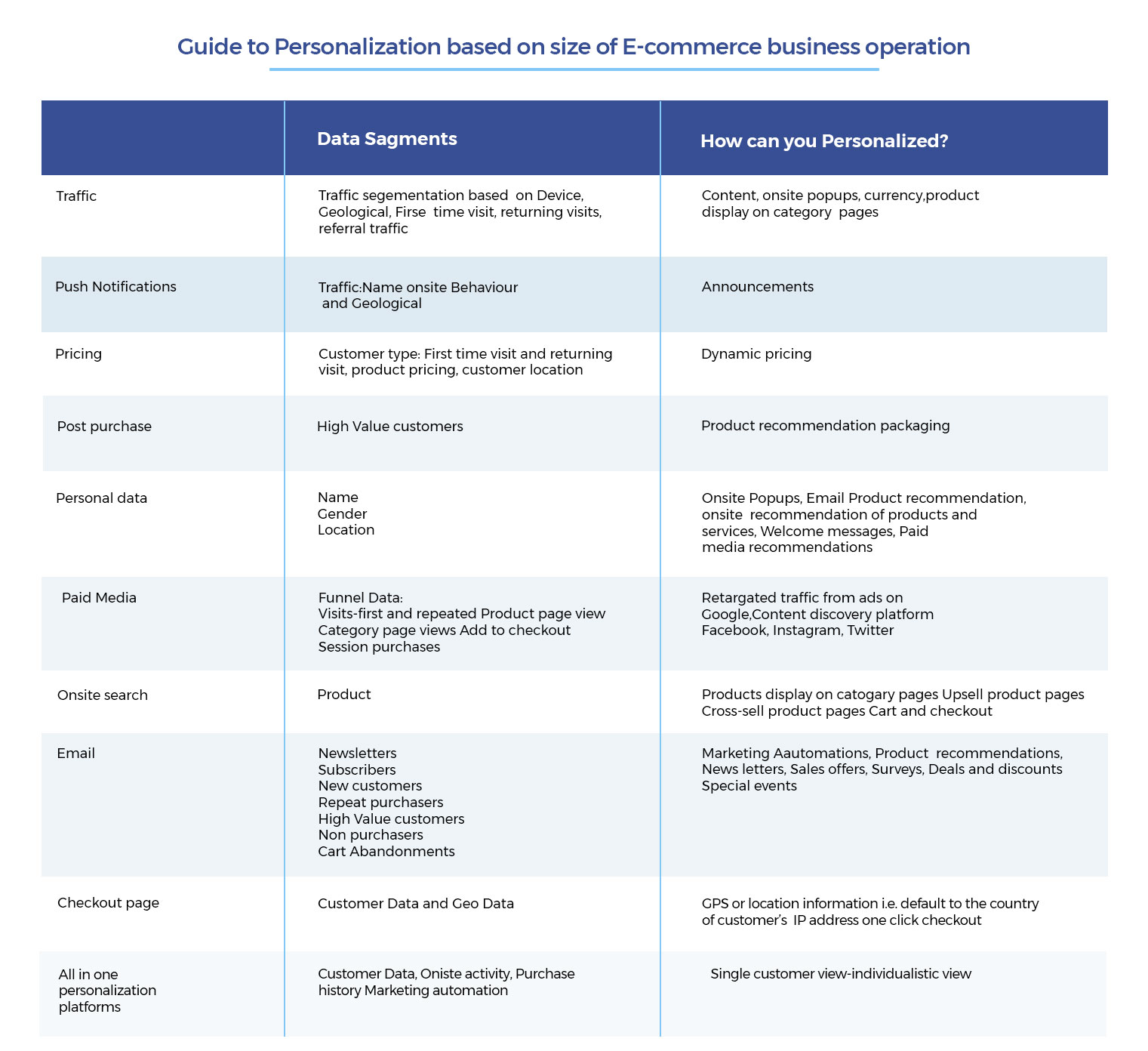
Real-time customization and personalization depend on noticing how the prospective customer or visitor behaves differently or aligns with typical behavior. You identify the current goal through the behavior and behavior of similar users and use insights through all levels to help accomplish goals.
Understand Audience:
Understanding the needs of the customer is the essence of personalization. With the blend of the right tech and knowledge to use it, you need to give customer satisfaction. It is vital for a new visitor and familiar customer that you assemble clues from the time they enter the site and determine the purpose of coming. Identification of intent can shorten the customer journey and this shall enhance the experience.
Knowing and understanding the audience you have to know about if they visited a site from an advertisement from social media, or through search, are they looking for a particular service or any product, etc. Personalization would be displaying items or content that is related.
With digital platforms and AI businesses can take care of scale and ensure related products, services, and content to visitors.
Let us take the example of an electronics retailer- if your customer ordered a laptop recently you can show related products like accessories of computer, carrying case and desktop porting station, etc.
Semantic Understanding for personalization search:
The search box is important real estate of any site. Personalized search is a huge opportunity as visitors use search convert which is 1.8 times high rate as compared to the average visitor.
Many search functions on-site may hurt as they help as it focuses on keywords instead of the meaning of the words in context and content. The search could be messy. Differences in how people describe the same product affect accurate search results and make it a struggle. Spelling mistakes, broad terms, etc. impact search.
Practically this is the difference between intelligent search and dumb search. Most of the marketing platforms search for words alone- a recipe for failure.
For example when a person searches Budget Black Laptop, what they want is a Black color low-cost computer but keyword results will show low-cost black accessories of laptop.
The intelligent and semantic search considers words in context just like a human clerk will understand. Intelligent semantic search capabilities have a huge advantage to having happy customers.
E-commerce businesses, manufacturers, brands, retailers, and distributors all need search engines and bring the business into a search engine. They need to create a guided and merchandised-driven selling experience.
Intelligent semantic search solutions:
- Offer set of selling capabilities other than the search box
- Enable sellers such that they can sell new products since the last visit of customers
- Help in-store customers to locate products on the kiosk
- Promote parts of already purchased products or products on the waiting list or shopping cart
It means sellers could deliver a personalization experience and recommendation to customers that are searching and browsing on landing pages. This eliminates the need to combine disparate products with multiple software vendors.
The experience of the users gets personalized with regards to their preferences shown in past. The semantic search's main goal is to make it easy for users to find what they are looking for.
For example, if a user shows interest in female products like skirts, dresses, cosmetics, etc. then search technologies will give preference to female items as the user is more likely to be female.
Targeting and Profiling:
Just like a salesman accompanies you around showroom E-commerce business too can virtually accompany visitors. The only trick you will have is you will be invisible. To make this work is by letting machine learning process all information, match against your inventory in real-time, and showcase the results.
Machine learning can guide customers at blazing speed and also offer options that customers might have missed as AI recognizes patterns in visitors’ behavior and match with the segment of buyers who have similar characteristics.
AI can identify a completely new customer segment that your team might overlook. Adding intelligence to user experience helps in providing real-time assistance to the users.
Personalization:
E-commerce Personalization is a powerful tool where you have rich data about the customers and because of it, you can significantly change products and services that you show to individuals. This will require rapid data aggregation, data analysis, cross-channel deployment, and AI optimization.
The lack of data leads to challenges in personalization for any company. With the right personalization solution, the marketers will be able to use deep-level data to provide one on one personalization through layout, content, browse, and search.
With personalization, you can return accurate results for visitors relying on AI by ensuring the search is always learning and gets better. You will be able to deliver accurate recommendations based on browsing history and search behavior. Examples are ‘You might like... Others also purchased’ are common prompts on E-commerce sites that signal product recommendations.
How to Get Started with Personalization:
- Understand what, how, and where you want to have personalization for the site and visitors. The decision must be made depending on where the most impact on revenue will be.
- Research on available tools and features of E-commerce personalization tech and tools and decide on how to get learning them.
- Assign enough resources to personalize projects and delegate responsibilities and decide on who will see the projects. Ensure the head can measure gains.
- Define long-term strategy and optimization process with personalization.
- Start segmentation and personalization of your site and keep a tab on areas your site benefits most because of personalization.
- You need to continue tracking and monitoring the results of the implemented strategies.
- Optimization if and where needed
- Once strategy shows results and your business is experiencing growth scale across channels.
Personalization vs Segmentation
Segmentation is customer groups that are based on shared activities, likes, and dislikes. Personalization is about minute differences that are used to target customers at an individual level.
Traditionally businesses have used customer segmentation to be part of the marketing strategies to ensure customers receive offers and communications which are relevant to them. But this attempt struggles to achieve a deep level of personalization.
Increasing segmentation is a good approach but it will not result in the best ROI or maximize effectiveness. AI-powered personalization delivers optimal results as it allows companies to tailor-make the marketing efforts at an individual level by using data that is gathered from the particular customer. It is a segment of one approach which optimizes whom you want to target with key messages like the offer, coupon code, unique recommendations, etc. all shared through appropriate and relevant channels.
Personalization can be achieved in degrees ranging from recommendation engines, connecting offline and online sales channels, and predicting customer preference. To develop tailored products, services and pricing is personalization. It is a holistic marketing strategy that fundamentally will change the way business interacts with customers. It is treated as evolving and maturing practice that is embedded into the customer journey and critical to marketing campaigns. Deep relationships develop with current customers and attract new customers.
Personalization Means Delivering Individual Experience
Brands are competing for customers’ attention in the crowded digital landscape, they must look for opportunities that allow them to interact with customers more efficiently and offer the highest probability for conversion.
Customer data is gathered through the customer journey and combined with information from external sources for engagement with customers to predict what they want even before they have to look for it to the competitor.
Personalization applied throughout Customer Journey
Personalization is applied throughout a customer journey is mentioned all over. It means that personalization such as personalized web pages, personalized pricing, personalized services post-purchase, etc.
Personalization marketing and advertising use platforms and data to present a multitude of targeted deals, offers, and discounts based on who is viewing it.
94% of customers find personalized advertising very appealing. Businesses experiment with personalization after the advertising phase, as it increases sales conversion. They use recommendation engines that serve customers with the products they are looking for.
With technology and the right platform, the personalization experience has become as seamless as customers may not even realize personalization is occurring. The customers are now expecting it from brands. Brands like Starbucks and Amazon are pioneers of personalization as they predict products that fit customers’ needs.
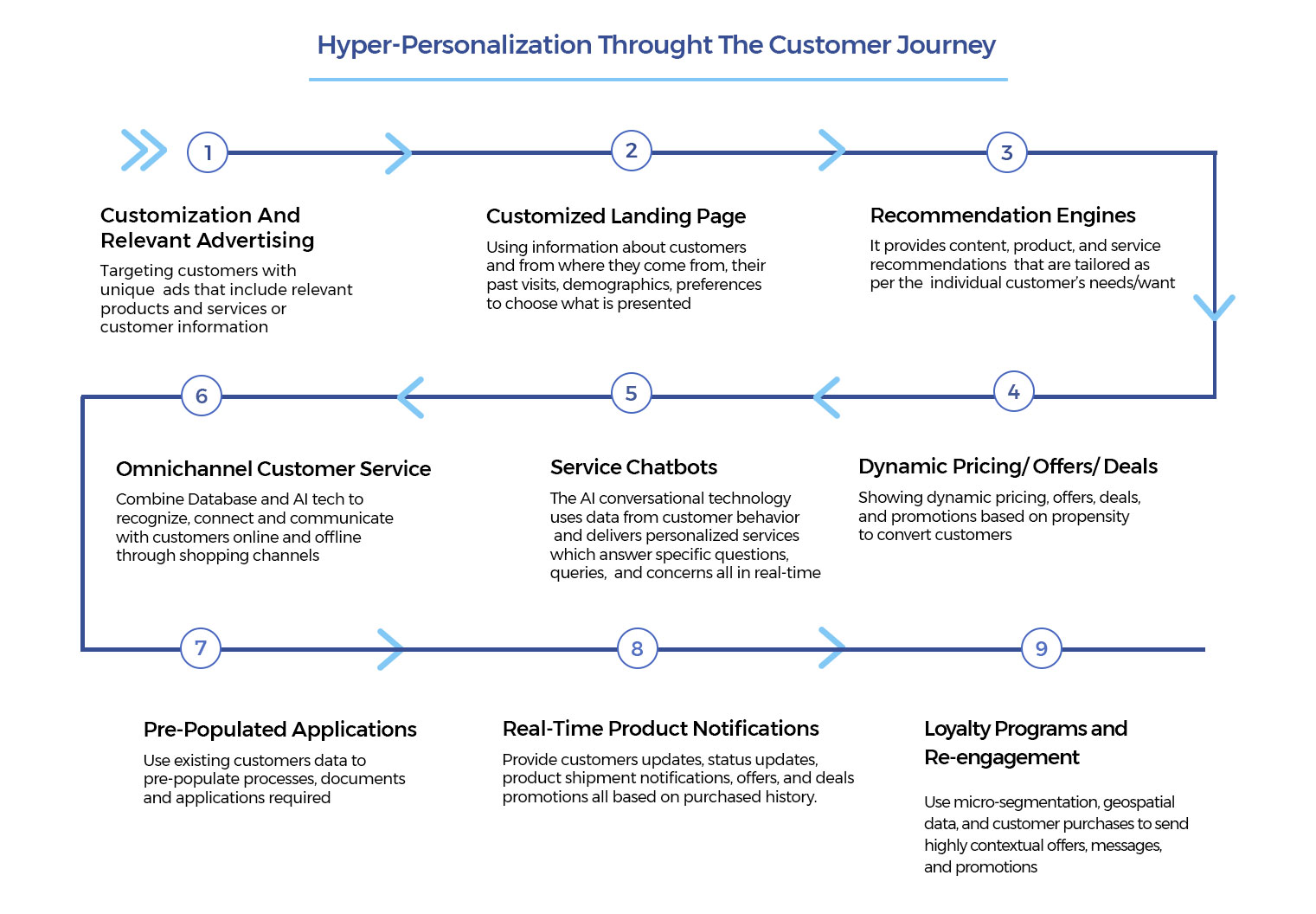
To effectively compete the businesses need to make meaningful and relevant impressions on the customers. To take full advantage of personalization means to cut through the noise and provide what customers are exactly looking for. Assist customers in decision-making and foster deeper relationships to keep them from seeking out any of your competitors.
Retailers Personalizing Shopping Experience
The retailers are personalizing shopping experience with relevant product recommendations and customized pricing. It is more about relevancy. More personalization leads to better and relevant offers. Personalization offers differentiation based on their engagement and interactions with particular brand.
The retail businesses marketing professionals use customer data to understand the customer’s desires before they enter marketplace. Insights are like guiding star for Retail leaders to promote brand in relevant manner to attract more customers and have high probability of conversion.
Different levers such as pricing, bundling, and advertising are used. As customer enters marketplace retail online store or offline personalization is ensuring unique shopping experience.
For example in E-commerce personalization virtual shopping associate or customized products etc.
These experiences change retail from being just retail experience to making it a brand.
Retail industry has accelerated sales with personalization through omnichannel.
For example: With behavioural analytics that will sort products to maximize conversation. As customer walks into store or visits online store he or she can use mobile technology to get recommendations and be directed to various products and departments or product pages.
The AI and advance technology integrated solutions has made personalization a robust marketing strategy that has impacted sales in retail industry. Customer experience is heartbeat of sales today. More and more E-commerce companies are integrating tactics with updated digital age.
Time to step in to Personalization with Ecommerce
Marketing is about a brand’s ability to have meaningful connections with customers. Personalization marketing is an essential part of the successful strategy as tech-enabled customer data increases, expectations of customers evolve and the marketplace becomes fiercely competitive.
Data, Data Analytics and Metrics, and AI advanced technology are essential tools to craft personalization to forge deeper bonds with the customer and thus excel in the marketplace.
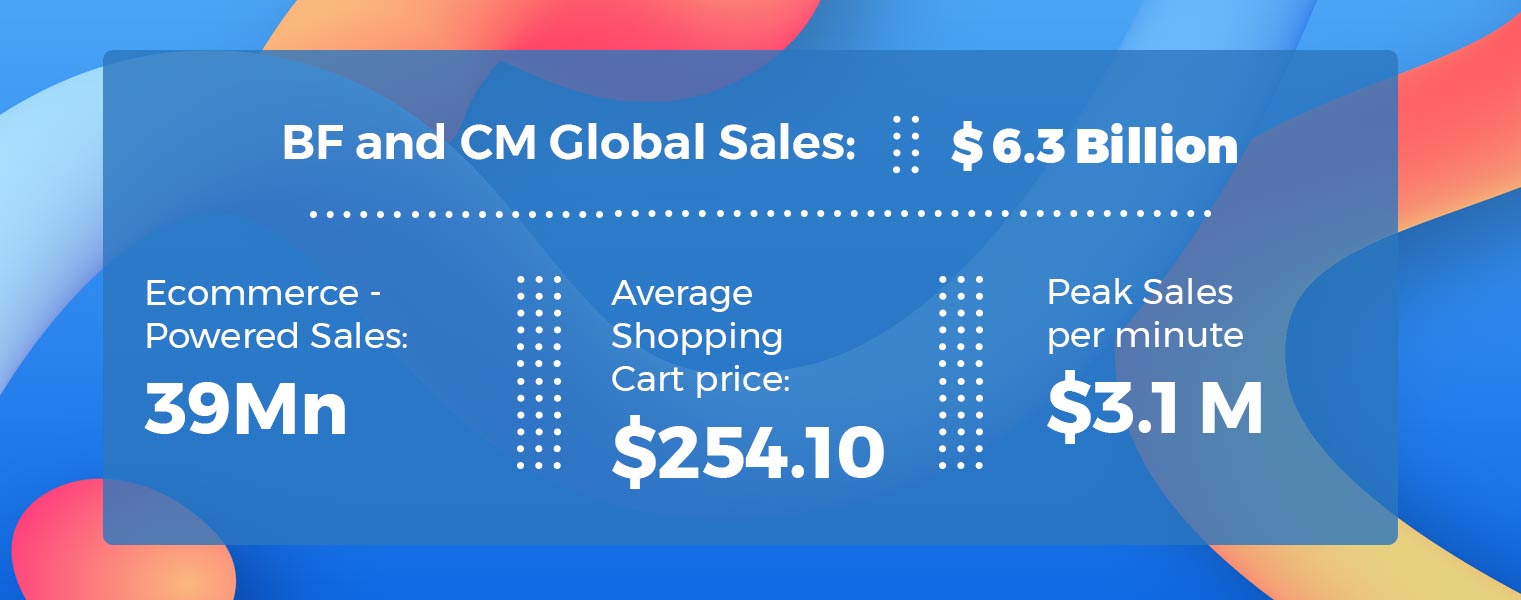
For every CMO- it is time to take it personally when planning and executing a robust marketing strategy. The CMO’s need to ensure the strategies and communications pivots in a real-time and dramatic reduction in budget and demonstrate sensitivity to the lives of customers.
CMO has to respond to changing consumer perceptions, changing market conditions, and the ability to leverage customer data at a granular level.
Businesses need to enable personalization across E-commerce, marketing automation, and customer engagement platforms to provide context to every interaction.
Related Articles
Digital Transformation
A Comprehensive Guide to Java Development
Digital Transformation
Leveraging AI And ML in .NET Applications: A Comprehensive Guide
Digital Transformation
A Comprehensive Guide to Building a Flutter App Effectively

